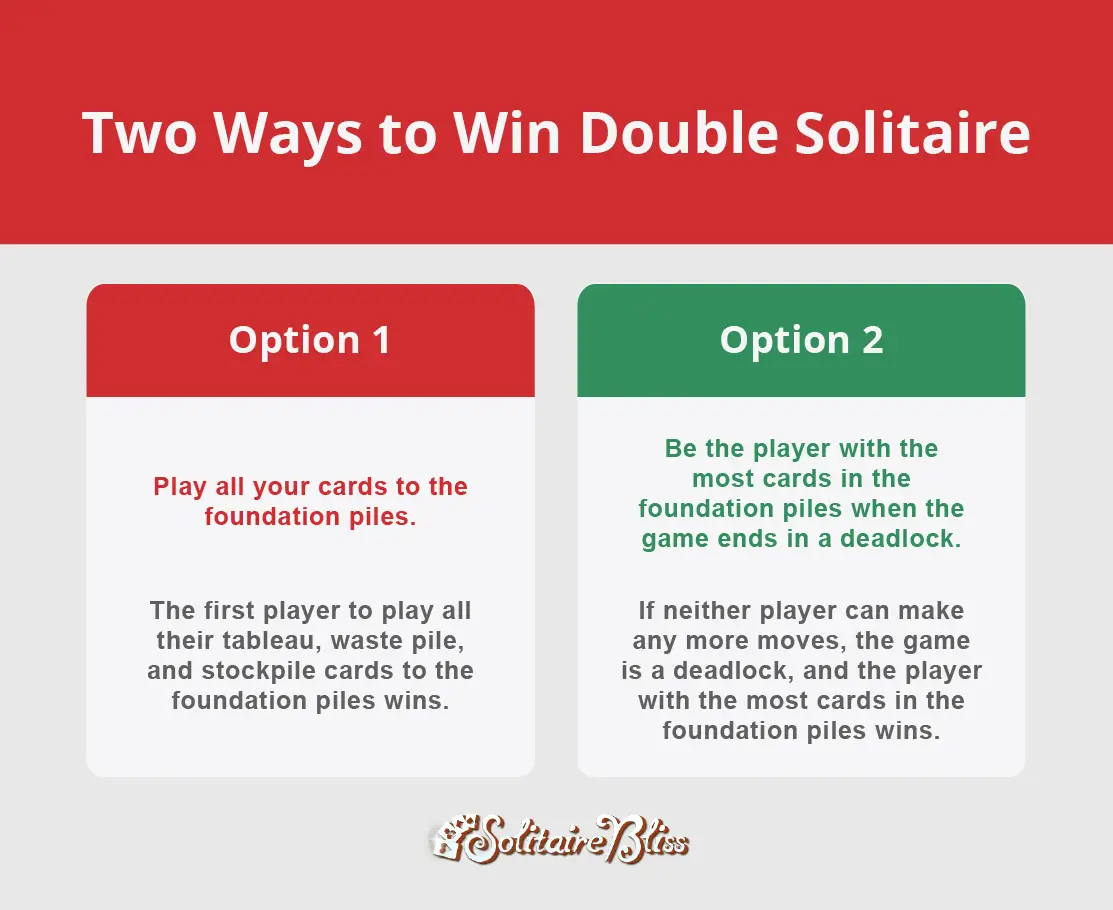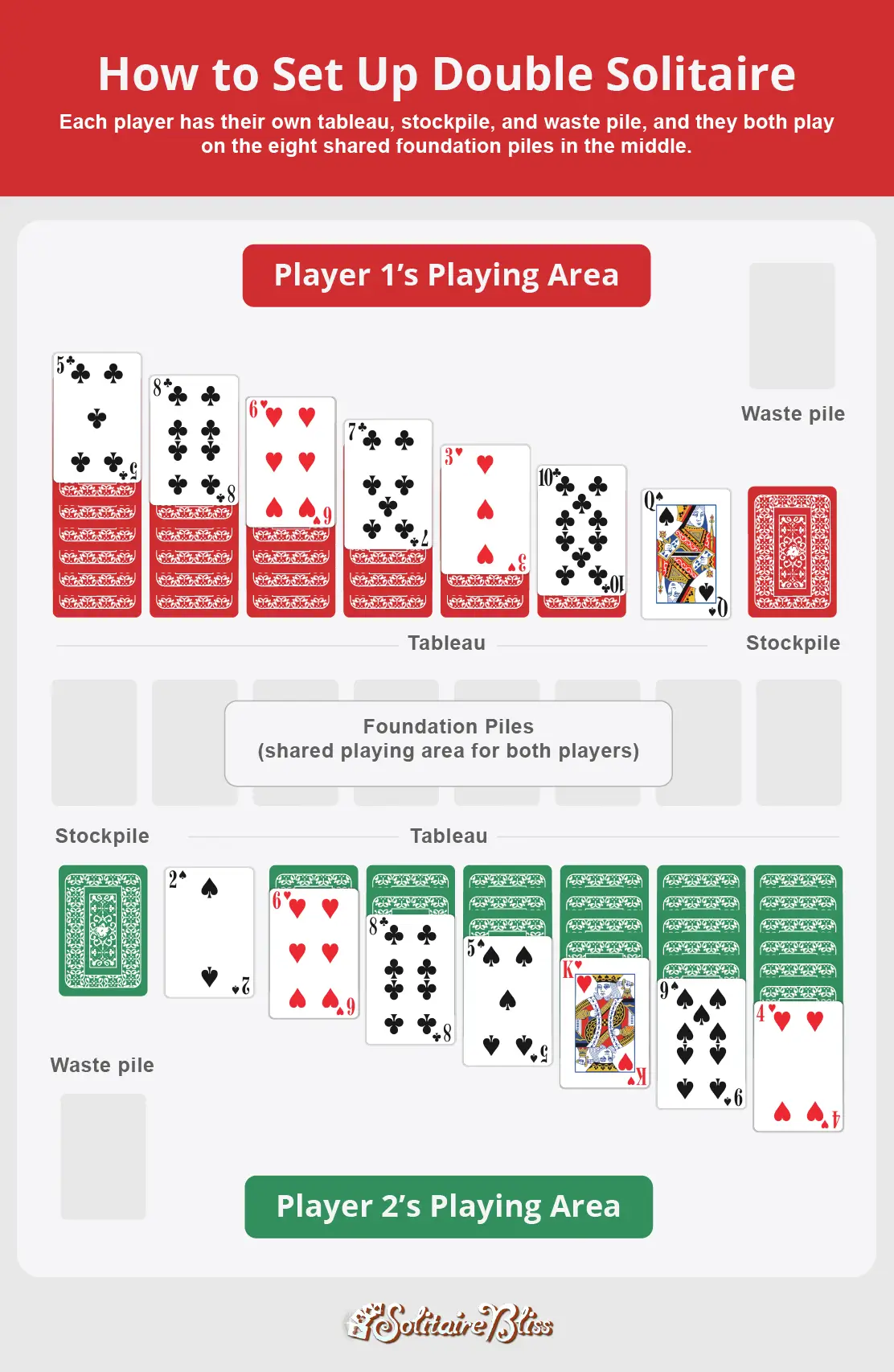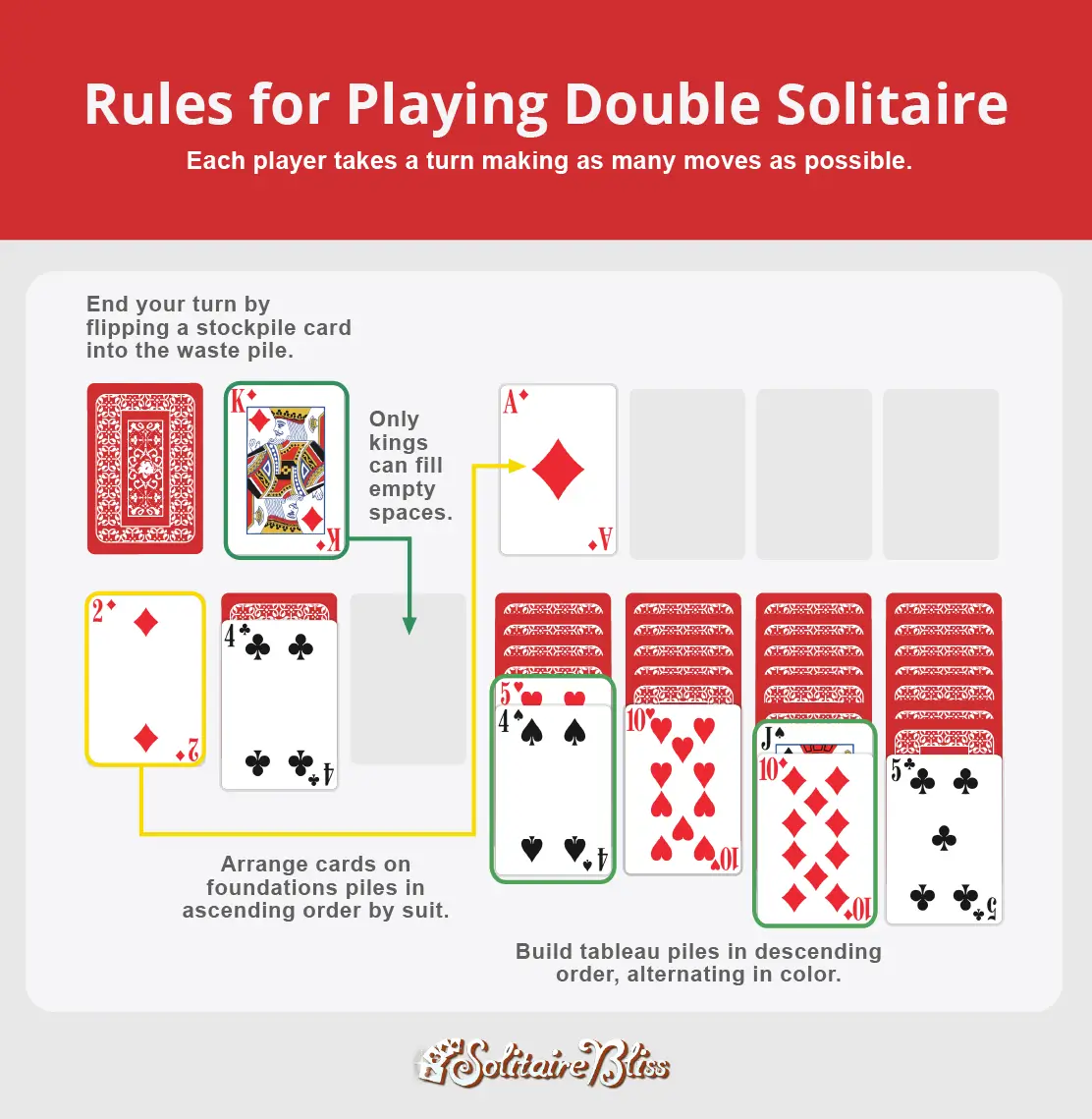How to Play Double Solitaire: Rules and Strategies to Win
Double Solitaire is a two-player Solitaire card game that has the same goal as Classic Solitaire—move all your cards from your tableau, stockpile, and waste pile to the foundation piles. But because you play head to head with another player, you must be the first to complete your foundation piles to win.
Sometimes, the game becomes deadlocked, and neither player can make any more moves. When this happens, the player with the most cards in the foundation piles wins.
Played with two standard decks, each player has their own tableau but shares eight foundation piles. That means your opponent may play on foundation piles before you do and thus may block your plays.
This post details the rules and strategies for Double Solitaire so you can play to win. But if you don’t have cards or another person to play with, you can play a version of Double Solitaire online with Solitaire Bliss.
The Objective: Two Ways to Win Double Solitaire
Double Solitaire doesn’t always end the same way, so you have two ways to win.
- Be the first player to clear your tableau, stockpile, and waste pile by moving all your cards to the foundation piles.
- Be the player with the most cards played into foundation piles after a deadlock. Like Klondike Solitaire, moving all your cards to the foundation piles means you win, but with Double Solitaire, you often reach a point where neither player is able to move but there are still cards in the tableaus. If that’s the case, the game is a deadlock, and the player with the most cards played on foundation piles wins.

How to Set Up a Double Solitaire Game
You set up Double Solitaire the same way you set up Solitaire for a single game, but because you have two players and two decks of cards, you have two of everything. Using decks that look different makes ending the game and counting up the cards, if necessary, easier.
Set up the game head to head, sitting across from each other, with each player dealing out their own tableau with their own deck. Then play individually with all piles except the foundation piles, which you share.

These Solitaire terms will help you set up the game and understand how each pile is used.
- Tableau: Each player should set up their own playing area by dealing seven columns of cards. Each column should have the same number of cards as its column number. So the first column has one card, the second column, two cards, and so on until the seventh column has seven cards. Only the last card of the column is face up. The rest are facedown. The tableau is where you arrange cards in descending order, alternating color, so you can reveal facedown cards and play cards into their foundation piles. Each player will only play on their tableau, not their opponent’s.
- Stockpile: The remaining cards become your stockpile and are placed facedown to the left of your tableau. Like your tableau, your stockpile isn’t shared, so you are the only one that will use it. You can play the stockpile in two ways. You can either turn over one or three cards at a time, placing them face up into the waste pile, just like Solitaire Turn 1 and Solitaire Turn 3. However, the stockpile for Double Solitaire differs from the classic version because you only turn cards over from it to end your turn, not to draw cards to play during your turn. You can use those waste pile cards on your next turn. If you exhaust your stockpile, just turn the waste pile facedown as the stockpile and begin again.
- Waste pile: The waste pile contains face-up cards that have been flipped over from the stockpile. Because you turn cards over from the stockpile to end your turn, you won’t have anything in your waste pile until your second turn. However, you can use the top card of your waste pile during your turn to make plays.
- Foundation piles: Between your tableaus, make room for eight piles so that you can both access them—this is where you’ll create foundation piles, the only shared resource during gameplay. You begin a foundation pile with an ace, and play cards in ascending order from ace to king by suit. Both players share all the foundation piles regardless of who starts them. During your turn, move cards from your waste pile or tableau to the foundation piles.
Double Solitaire Rules
You follow the same basic game rules for Double Solitaire as you do with classic Solitaire. So if you know how to play Solitaire already, you just have to adjust for a couple of special features when playing with an opponent.

Play Double Solitaire by following these rules:
- Decide who goes first. You can likely just agree who goes first and then alternate with each new game, but if you’re quite competitive and need a way to decide, the player who has the highest ranking card in the first tableau column goes first.
- Play one at a time until you’re out of moves. Each player takes turns playing individually, making as many moves as possible while their opponent looks on. They can arrange cards on their tableau, begin foundation piles, and place cards into foundation piles.
- Build tableau piles in descending order and alternating color. Tableau piles must be arranged in descending order and opposite color. So, for example, a jack of hearts can have a black ten placed on it. You can move individual cards or entire columns as long as you follow this rule for tableau cards. For example, if you had a sequence of cards that was a black six, red five, and black four, you could place that entire sequence on top of a red seven.
- Build foundation piles in ascending order by suit. Foundation piles are separated by suit and begin with an ace. They are built in ascending order from ace to king. These piles are shared, so even if you didn’t begin the pile you can build on it.
- Only kings can fill empty spaces. If you remove all the cards from a tableau column, you can only move a king into that empty space or a sequence of cards that begins with a king.
- Reveal facedown cards on the tableau when all the face-up cards are removed. As you arrange cards in your tableau, you will eventually uncover facedown cards. Once they are uncovered, you can reveal the facedown card by flipping it face up. Then you have another card to play. The waste pile works in the same way. Once you use a face-up card from the waste pile, another face-up card is then available to be played.
- Flip over a stockpile card into the waste pile only to end your turn. In Solitaire, you rely on the stockpile to create more moves, but in Double Solitaire, you don’t get unlimited access. You only turn over a card into the waste pile to end your turn, not to continue playing. Then you can use that waste pile card during your next turn. Once you’ve gone through the stockpile, turn the waste pile over (do not shuffle), and use it again.
- You have access to cards in the waste pile—not the stockpile. For the first turn, you won’t have any waste pile cards because you haven’t flipped from the stockpile to end your turn. When you do have waste pile cards, you can use the top card during your turn and any card you reveal underneath. So you can work through your waste pile during a single turn, but you can’t turn more cards over from the stockpile.
- Be the first player to clear their tableau and stockpile wins the game. Continue playing one at a time until one player wins by clearing all their cards from both the tableau and stockpile.
- If the game ends in a deadlock, the person with the most foundation pile cards wins the game. If both players have cycled through their stockpile without making any moves, the game is deadlocked. Typically, players make it through their stockpile two or three times before a deadlock is reached. Count the cards each player placed into foundation piles, and the one with the most cards is the winner.
Strategies for Playing Double Solitaire
Most Solitaire strategies for a single-player game work just as well for Double Solitaire, but when you play with an opponent, you definitely want to win. When that opponent shares foundation piles with you—the key to winning the game—you want to be sure you focus on the right strategies for this Solitaire variation.
Build Lengthy Tableau Sequences
Just like regular Solitaire, this sounds counterintuitive, but building long sequences gives you two advantages. You have a lot of cards ready to move to foundation piles, and you give yourself a chance to reveal facedown cards in your tableau.
You might worry that your opponent is building more on foundation piles, but because there are double the foundation piles, you have just as much of a chance to build on piles as your opponent. Besides, at first, many aces won’t be played, so if you focus on building tableau sequences, you get more cards in play and in order so they can be played onto ready foundation piles.
Aces and twos are the exception to this rule. Play those cards immediately. However, if you play more ranks than that and create uneven foundation piles, you could deadlock by losing cards to the foundation pile that you needed in the tableau to arrange cards.
Strategize with Your Waste Pile Cards
Once you end your turn, your tableau won’t change, but you have a new waste pile card to consider. Strategize your next moves with the new card you flipped onto the waste pile while the other player arranges cards.
As you turn cards from the stockpile into your waste pile, try to remember the cards you placed there. You can plan to work through the waste pile on your next turn, or plan for how you’ll use those cards when you refresh the stockpile.
Time Your Plays to Foundation Piles
Since you want to win, you have to keep an eye on your opponent’s progress. You can see if they’re heading for a deadlock by playing every card to the foundation pile, and you can see how many facedown cards they’ve revealed as well as how many stockpile cards they have put into play. By watching your opponent’s tableau, you can determine the best time to start playing several cards onto foundation piles.
If your opponent is heading for a deadlock, you have to start building foundation piles with your cards. That way, you can have the best chance of winning with the most cards in the foundation piles. Similarly, if you see your opponent is clearing their tableau and has several stockpile cards into play, start dismantling your tableau sequences so they can move to foundation piles. This gives you the best chance at blocking your opponent from building further as well as getting you closer to winning.
Block Your Opponent
You might be able to figure out your opponent’s strategy since you can see all their cards and how they play. So take the opportunity to anticipate what move they are planning and try to block it.
For example, if you can play a six of clubs to the foundation pile, but that’s all they need to unlock several moves and create a long run on the foundation piles, consider keeping the six in your tableau.
If playing the six is the last move you can make, definitely keep it in your tableau. Otherwise, you’ll waste a move that gives your opponent a way to make several. If the card can unlock several more plays for you, you have to weigh the advantage those plays will give you against the advantage you give to your opponent.
Double Your Fun with Double Solitaire
Although Double Solitaire requires an opponent, you have options if you’re playing solo. You can play a version of Double Solitaire as well as other Solitaire variations like Spider Solitaire or FreeCell for free on Solitaire Bliss.
Back to the Homepage

